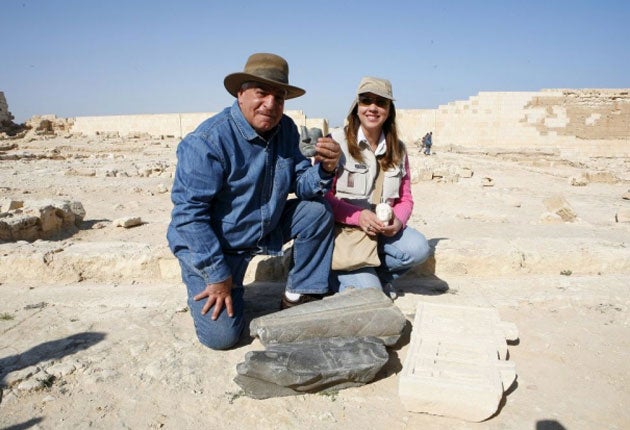Egypt, thou knew'st too well: is Cleopatra's final secret out?
Archaeologists believe they are on brink of discovering queen's final resting place

Just as he did fictitiously with Romeo and Juliet, William Shakespeare immortalised Antony and Cleopatra as a tragic tale of a defeated couple. But unlike Verona's star-crossed lovers, Marc Antony and Cleopatra's final resting place has remained a mystery.
Now archaeologists believe they are on the cusp of a conclusive discovery. Three sites buried deep underneath the crumbling limestone of a 2,000-year-old temple are thought to contain a series of complex systems of tunnels which archaeologists believe could lead to the tomb of the two lovers.
And to prove it, Zahi Hawass, director of Egypt's Superior Council for Antiquities, showcased a range of items yesterday that have been found at the site at Burg El-Arab, nearAlexandria. They include 22 coins bearing Cleopatra's image, a fragment of a mask – with a cleft chin which he believes could belong to Antony – and 10 mummies of apparent nobles. "The discovery of the cemetery this week really convinced me that there is someone important buried inside this temple," he said. "No one would be buried outside a temple without a reason. We saw in the pharaonic days, they were always buried beside pyramids."
Urging caution, he added: "If you look at the face of Mark Antony, many believed he had this cleft on his chin and that's why I thought this could be him."
The discoveries follow excavations that started last week on three sites along the tunnels by teams from Egypt and the Dominican Republic. It is hoped that one of the deep shafts, identified by a radar scan, will lead to a burial chamber where the tomb will be found. Dr Hawass believes that the tomb could be "bigger than that of King Tutankhamen's", discovered in 1922.
It was more than two millennia ago when Mark Antony and Cleopatra challenged Caesar Augustus for control of the Roman Empire. Their armies were defeated and in 30 BC, rather than surrender, the two lovers committed suicide – Mark Antony by his sword, and Cleopatra with a poisonous asp.
The Roman historian Plutarch said Caesar allowed the two lovers to be buried together, but thelocation of their tomb was kept secret. "If this tomb is found, it will be one of the most important discoveries of the 21st century because of the love between Cleopatra and Mark Antony, and because of the sad story of his death," said Dr Hawass.
Kathleen Martinez, the Dominican archaeologist who has been working at the site for the past three years, said the Taposiris Magna temple was chosen after 12 years of studying the life of Cleopatra. Describing it as the "most sacred temple of its time", she argued that the lovers were "buried in a temple rather than a public tomb to protect them from the Romans".
But John Baines, an Egyptologist at Oxford University asked why Augustus, who defeated Antony, would have chosen such a distinguished burial place. "I don't see a particular connection between that site and Antony and Cleopatra," he said.
Several discoveries have already been made at the site. Last year, archaeologists unearthed a bronze statue of the goddess Aphrodite, the alabaster head of a Queen Cleopatra statue and another mask believed to belong to Mark Antony.
For most, Cleopatra will forever be imagined as the stunning seductress portrayed by Elizabeth Taylor, opposite Richard Burton in the 1963 Hollywood classic Cleopatra.
However, academics from the University of Newcastle recently poured cold water on this, claiming that the Egyptian Queen was a pointy-nosed, thin-lipped woman with a jutting jaw. Dr Hawass believes that the discovery of the coins that show Cleopatra with an "attractive" face, argued otherwise. "The findings reflect a charm ... and indicate that Cleopatra was in no way unattractive," he said.
Join our commenting forum
Join thought-provoking conversations, follow other Independent readers and see their replies
Comments
Bookmark popover
Removed from bookmarks